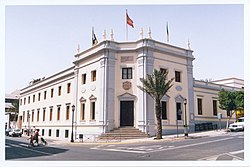

A cabildo insular (English: island council) is the government and administrative institution of each of the seven major islands in the Canary Islands archipelago: Tenerife, Fuerteventura, Gran Canaria, Lanzarote, La Palma, La Gomera and El Hierro. The island of La Graciosa falls under the jurisdiction of the cabildo of Lanzarote.
Contents
The members of a cabildo are elected by direct universal suffrage by the Spanish citizens of each island. The membership is determined by party-list proportional representation. In Francoist Spain the members were appointed rather than elected.
Originally created under the Law of Cabildos of 1912, [1] by 1925 the cabildos insulares had taken over powers ascribed to the provincial councils. [2] Cabildos exercise a level of authority between those of their province and their autonomous communities in matters of health, environment, culture, sports, industry, roads, drinking water and irrigation, hunting and fishing licensing, museums, beaches, public transportation and land organization. Cabildos can impose fuel taxes.





